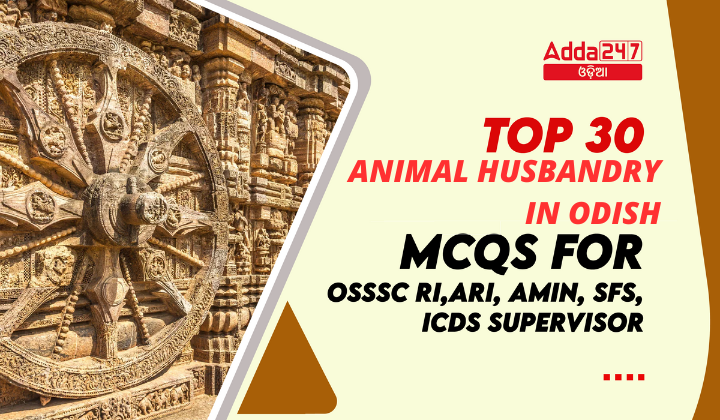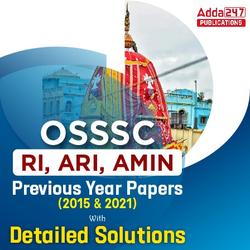Animal husbandry is a critical sector in Odisha, providing a significant source of livelihood and income for many people in the state. For candidates preparing for the OSSSC LSI, Forester, and FG examinations, understanding the key aspects of animal husbandry in Odisha is essential. The top 30 multiple-choice questions (MCQs) on this topic may cover areas such as livestock management practices, breed identification, animal nutrition, disease prevention, and various state and national policies affecting the sector. Candidates should be familiar with the major livestock breeds found in Odisha, including cattle, buffaloes, goats, and poultry, as well as the various conservation and improvement programs in place.
Top 30 Animal Husbandry in Odisha MCQs for OSSSC LSI, Forester, FG
- What is the human population of Odisha?
A) 3.5 crores
B) 4.4 crores
C) 5.0 crores
D) 6.5 crores
Answer:B) 4.4 crores
- How much does livestock production account for in India’s GDP?
A) 15%
B) 18%
C) 21%
D) 24%
Answer:C) 21%
- What percentage of income does the livestock sector generate for small and marginal farmers in Odisha?
A) 20%
B) 25%
C) 30%
D) 35%
Answer:C) 30%
- What is the main focus of the dairy and poultry development activities in Odisha?
A) To improve breeding
B) To augment livestock productivity in milk, meat, and egg
C) To increase cattle population
D) To increase exports of livestock products
Answer:B) To augment livestock productivity in milk, meat, and egg
- What government entities implement programs for livestock management in Odisha?
A) Only the State Government
B) Only the Central Government
C) The State and Central Government
D) Private entities
Answer:C) The State and Central Government
- What is the role of the Directorate of Animal Husbandry and Veterinary Services in Odisha?
A) Overseeing only the breeding of livestock
B) Overseeing only the feeding of livestock
C) Overseeing only the management of livestock
D) Overseeing breeding, feeding, and management of livestock and poultry
Answer:D) Overseeing breeding, feeding, and management of livestock and poultry
- What is the name of the sub-scheme under the Pradhan Mantri Matsya Sampada Yojana that was approved by the Union Cabinet for micro and small enterprises in the fisheries sector?
A) Pradhan Mantri Matsya Kisan Samridhi Sah-Yojana (PM-MKSSY)
B) Pradhan Mantri Matsya Udhyog Yojana (PM-MUY)
C) Pradhan Mantri Matsya Vikas Yojana (PM-MVY)
D) Pradhan Mantri Matsya Kisan Vikas Yojana (PM-MKVY)
Answer:
A) Pradhan Mantri Matsya Kisan Samridhi Sah-Yojana (PM-MKSSY) - What is the expected investment in the fisheries sector through PM-MKSSY in the next four years?
A) ₹2,000 crore
B) ₹4,000 crore
C) ₹6,000 crore
D) ₹8,000 crore
Answer:C) ₹6,000 crore
- What is the primary goal of PM-MKSSY?
A) To promote large-scale fishing industries
B) To support micro and small enterprises in the fisheries sector
C) To develop urban fisheries
D) To increase exports of fish products
Answer:B) To support micro and small enterprises in the fisheries sector
- Which ministry is responsible for implementing PM-MKSSY?
A) Ministry of Finance
B) Ministry of Agriculture and Farmers Welfare
C) Ministry of Fisheries, Animal Husbandry and Dairying
D) Ministry of Environment, Forest and Climate Change
Answer:
C) Ministry of Fisheries, Animal Husbandry and Dairying - What does PM-MKSSY aim to improve in the fisheries sector?
A) Fish exports only
B) Employment opportunities for skilled workers
C) Income of micro and small enterprises
D) Aquaculture technology
Answer:
C) Income of micro and small enterprises - Which scheme is PM-MKSSY a part of?
A) Pradhan Mantri Matsya Sampada Yojana
B) Pradhan Mantri Jan Dhan Yojana
C) Pradhan Mantri Gramin Awas Yojana
D) Pradhan Mantri Suraksha Bima Yojana
Answer:A) Pradhan Mantri Matsya Sampada Yojana
- What are some key areas of focus under PM-MKSSY?
A) Increasing fish catch only
B) Supporting micro and small enterprises, including infrastructure and technology
C) Promoting large-scale fish farming
D) Developing international trade relations for fisheries
Answer:
B) Supporting micro and small enterprises, including infrastructure and technology - How does PM-MKSSY support small enterprises in the fisheries sector?
A) Providing tax relief for large fishing companies
B) Offering financial assistance and technical support
C) Restricting fish imports to boost local production
D) Encouraging mechanized fishing methods
Answer:
B) Offering financial assistance and technical support - Which key aspect does PM-MKSSY emphasize in the fisheries sector?
A) Importing fish products
B) Sustainable and responsible development
C) Reducing employment in the fisheries sector
D) Decreasing fish production
Answer:B) Sustainable and responsible development
- What are the long-term benefits expected from the implementation of PM-MKSSY?
A) Reduced fish production in the future
B) Increased dependence on imported fish products
C) Boosted income and improved livelihood for small fisheries enterprises
D) Stagnation of the fisheries sector
Answer:C) Boosted income and improved livelihood for small fisheries enterprises
- What is the full form of PM-MKSSY?
A) Pradhan Mantri Matsya Krishi Samriddhi Sah-Yojana
B) Pradhan Mantri Matsya Kisan Samridhi Sah-Yojana
C) Pradhan Mantri Matsya Kishan Samman Sah-Yojana
D) Pradhan Mantri Matsya Kisan Suraksha Sah-Yojana
Answer:B) Pradhan Mantri Matsya Kisan Samridhi Sah-Yojana
- What is the name of the scheme that aims to enhance fish production by excavating new fish ponds in Odisha?
A) Matsya Utpadan Yojana
B) Matsya Pokhari Yojana
C) Matsya Krishi Yojana
D) Matsya Vikas Yojana
Answer:B) Matsya Pokhari Yojana
- What is the main objective of the Matsya Pokhari Yojana in Odisha?
A) Importing exotic fish species
B) Providing fishing gear to fishermen
C) Expanding freshwater fish production area by excavating new fish ponds
D) Exporting fish products
Answer:C) Expanding freshwater fish production area by excavating new fish ponds
- What is the name of the scheme launched by Chief Minister Naveen Patnaik to revive unused ponds in urban areas of Odisha?
A) Ama Pokhari
B) Matsya Utpadan Yojana
C) Matsya Krishi Yojana
D) Matsya Vikas Yojana
Answer:A) Ama Pokhari
- How many large water bodies in urban areas will be rejuvenated under the Ama Pokhari scheme?
A) 1,000
B) 1,500
C) 2,000
D) 2,500
Answer:C) 2,000
- How many urban areas will be targeted for the rejuvenation of water bodies under the Ama Pokhari scheme?
A) 100 urban areas
B) 105 urban areas
C) 110 urban areas
D) 115 urban areas
Answer:D) 115 urban areas
- What is the subsidy rate for setting up a state-of-the-art fish feed plant in Odisha under the CS Scheme-PMMSY guidelines?
A) 30%
B) 35%
C) 40%
D) 45%
Answer:C) 40%
- Under the CS Scheme-PMMSY guidelines, what is the capacity of the state-of-the-art fish feed plant for which the subsidy is applicable?
A) 50 tons/day
B) 75 tons/day
C) 100 tons/day
D) 125 tons/day
Answer:C) 100 tons/day
- Which type of water bodies will be targeted for rejuvenation under the Ama Pokhari scheme?
A) Freshwater lakes
B) Unused ponds in urban areas
C) Coastal fisheries
D) Mangrove swamps
Answer:B) Unused ponds in urban areas
- Which of the following is not a focus area of the Matsya Pokhari Yojana?
A) Expanding freshwater fish production
B) Importing fish species
C) Excavating new fish ponds
D) Enhancing fish production
Answer:B) Importing fish species
- What is the aim of rejuvenating and renovating the periphery of ponds under the Ama Pokhari scheme?
A) To build resorts around the ponds
B) To increase fish exports
C) To create healthy spaces for the public
D) To build shopping centers
Answer:C) To create healthy spaces for the public
- What does the subsidy provided under the CS Scheme-PMMSY guidelines aim to support in Odisha?
A) Import of foreign fish species
B) Setting up state-of-the-art fish feed plants
C) Export of fish products
D) Creation of ornamental fish farms
Answer:B) Setting up state-of-the-art fish feed plants
- What other development activities are being focused on in Odisha to support the fisheries sector?
A) Importing fish from other states
B) Boosting fishing tourism
C) Enhancing fish processing units
D) All of the above
Answer:C) Enhancing fish processing units
- What is the name of the Rooftop Rainwater Harvesting Scheme launched by the Odisha government?
A) Odisha Water Conservation Program
B) CHHATA
C) Odisha Rainwater Harvesting Initiative
D) Aqua Odisha
Answer:B) CHHATA
- How long will the CHHATA scheme be implemented?
A) 2 years
B) 3 years
C) 5 years
D) 10 years
Answer:C) 5 years
- What does CHHATA stand for?
A) Community Harvesting and Harnessing Aquatic Technology for Agriculture
B) Community Harnessing and Harvesting Rainwater Artificially from Terrace to Aquifer
C) Community Harvesting and Harnessing Aquatic Resources for Agriculture
D) Community Harvesting and Harnessing Water Resources
Answer:B) Community Harnessing and Harvesting Rainwater Artificially from Terrace to Aquifer










